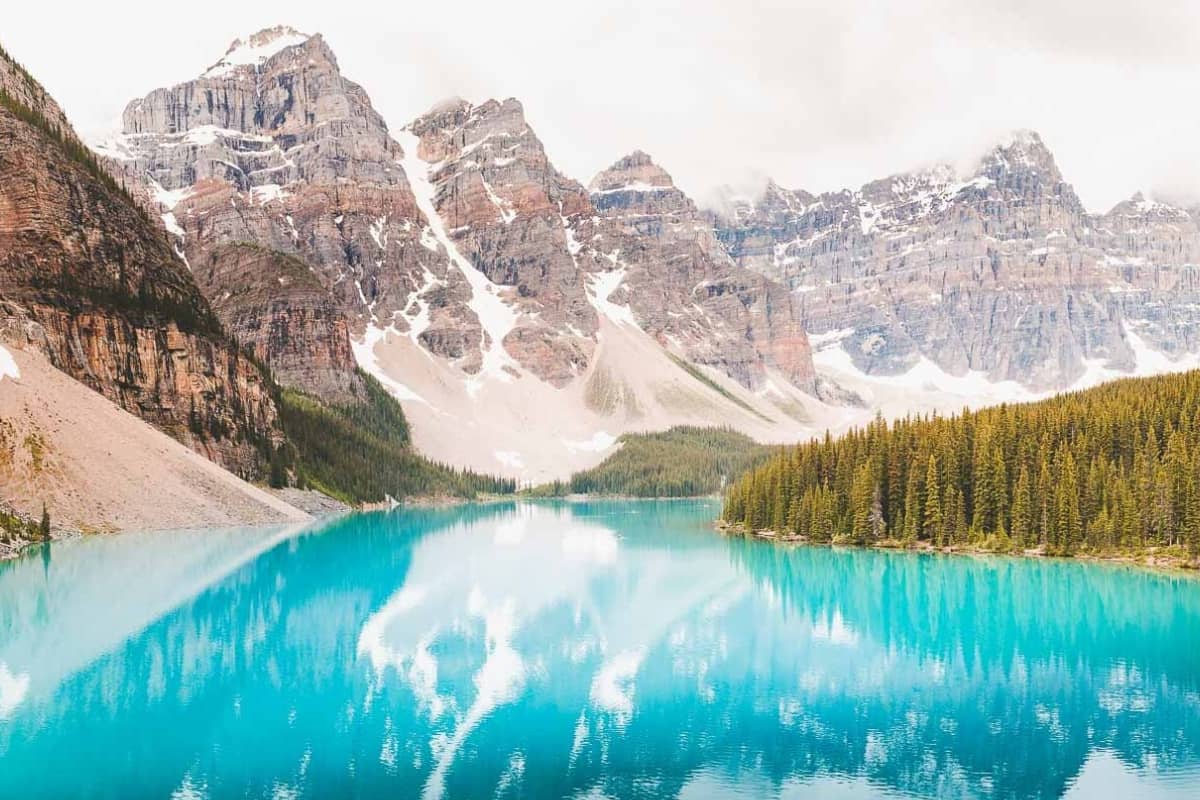Moraine Lake in Banff National Park, Alberta, is a world-renowned destination, famous for its glacial blue waters and rugged mountainous surroundings. Visitors from all over flock to this iconic Canadian site, but it’s essential to understand that Moraine Lake is not without its hidden dangers. These risks, though often overlooked, can turn a beautiful trip into a perilous one. Below are six hidden dangers that every visitor to Moraine Lake should be aware of to ensure a safe experience.
1. The Perils of Avalanches and Rockslides
Moraine Lake is encircled by towering peaks that create a majestic view, but they also present significant avalanche risks. Especially during the transition from winter to summer, the melting snow increases the likelihood of avalanches. The sheer cliffs and loose rock formations along the shoreline add to the danger. Hikers and climbers must remain vigilant, as the steep chutes of loose rock can cause debris to fall without warning.
Avalanche danger is particularly pronounced in the early spring and late autumn. It is critical to heed trail closures and warnings issued by Parks Canada to avoid these areas when the risk is high. Those planning to hike during these seasons should have proper avalanche knowledge and gear. The trails around the lake, while popular, are not immune to the unpredictable nature of the Rockies, making preparedness and awareness key to safety.
2. The Ever-Present Risk of Hypothermia
The mesmerizing blue water of Moraine Lake is alluring, but it’s dangerously cold year-round, fed by the glaciers that surround it. Water temperatures hover just above freezing, even in the peak of summer. Falling into the lake, especially during activities like canoeing or kayaking, can lead to hypothermia in minutes.
Many visitors are unaware of just how cold the water is until it’s too late. Hypothermia can set in within 10 to 20 minutes of immersion, depending on various factors like the air temperature and wind chill. Staying out of the water and avoiding any risky behavior around its edges is strongly advised. If engaging in water activities, wearing a life jacket and appropriate thermal protection is crucial.
3. Limited Access and Emergency Services
As of 2023, Moraine Lake is no longer accessible by private vehicles. Visitors must use a shuttle or opt for organized tours to reach the lake. While this helps preserve the area from overcrowding and reduces environmental damage, it also makes emergency situations more complicated.
In the event of an accident, such as a fall or medical emergency, the absence of quick access to private vehicles or on-site emergency services poses a significant risk. Shuttle services operate on a fixed schedule, and accessing medical aid in a timely manner can be difficult. For visitors venturing off the beaten path, this remoteness can exacerbate the dangers of any accident. Travelers should ensure that someone knows their itinerary and should be equipped with communication devices that work in remote areas, as cell reception can be spotty.
4. Wildlife Encounters – A Real Threat
Moraine Lake is located in prime bear country, which means visitors are in proximity to both grizzly and black bears. While bear encounters are rare in crowded areas, those heading into more remote sections for hiking or photography must remain vigilant. Parks Canada strongly advises carrying bear spray, as well as traveling in groups and making noise while on the trails to avoid surprising any wildlife.
Bear spray can be purchased from many stores in Banff or rented from hotels, but knowing how to use it effectively is crucial. Bear sightings, though rare, have occurred in the Moraine Lake area, and unprepared hikers could find themselves in a dangerous situation.
Aside from bears, there are also risks from smaller animals such as coyotes, which can be aggressive if threatened. While enjoying Moraine Lake, always maintain a respectful distance from wildlife and never feed any animals, as this can provoke unpredictable behavior.
5. Strong Glacial Currents
Despite its serene appearance, Moraine Lake hides strong glacial currents, particularly near the far end of the lake where runoff enters from surrounding glaciers. For kayakers or canoeists, these currents can be surprisingly strong and challenging to navigate. Paddling too close to these areas can result in a sudden loss of control, increasing the risk of capsizing.
The glacial stream flowing into the lake brings powerful water pressure that can push small watercraft away. It’s easy to misjudge the force of the current, especially in such a tranquil setting. Even experienced paddlers should take extra care and stay clear of these zones, favoring the middle sections of the lake for a safer experience.
6. Overcrowding and Overconfidence
One of the most underestimated dangers at Moraine Lake comes not from the natural environment but from overcrowding and visitor behavior. As a popular tourist destination, the lake can become heavily congested, especially during peak summer months. This crowding creates risks of accidents on the narrow trails or from inexperienced visitors attempting to climb the surrounding rock piles for the famous “Twenty Dollar View.”
Overconfidence is another danger, especially among visitors unfamiliar with mountain environments. The short Rockpile Trail is often underestimated, with many visitors climbing the loose rocks near the viewpoint for better photos. Falls from these rocks are a common hazard, and several accidents have occurred due to poor footwear or misjudged steps.
For those hiking further afield, such as to the Larch Valley or Sentinel Pass, altitude sickness and rapidly changing weather conditions can pose significant threats. Visitors often underestimate how quickly weather can turn from sunny to severe, leading to unexpected and dangerous situations.
Safety Precautions for a Safer Visit
To enjoy Moraine Lake safely, preparation is essential. The right gear, including sturdy hiking boots, weather-appropriate clothing, and bear spray, is vital for any hiking or paddling excursion. In addition, understanding the risks and respecting trail closures will help avoid the more serious dangers such as avalanches and wildlife encounters.
Visitors should also plan their trips around shuttle schedules, ensuring they have ample time to enjoy the lake without being stranded. Early morning visits are ideal for avoiding crowds and enjoying the serene beauty without the stress of overcrowded trails.
Lastly, always be aware of your surroundings, whether it’s the precarious rock formations or potential encounters with wildlife. With the right precautions, Moraine Lake offers one of the most spectacular landscapes in the world, but respect for its power and dangers is essential for a safe and memorable visit.
By acknowledging these hidden dangers, you can better prepare for a visit that’s not only stunning but also safe, ensuring that Moraine Lake remains a highlight of your trip to Banff National Park.






